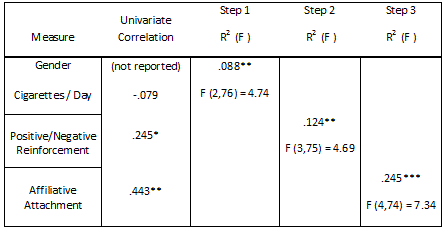The National Institute on Drug Abuse estimated that people with psychiatric disorders purchase 44 % of the cigarettes sold in the United States (NIDA, 2011). Young adult smokers in particular are more likely to exhibit negative affect and psychiatric disorders (Magid, Colder, Stroud, Nichter, & TERN members, 2009; NIDA, 2011). Interestingly, research has shown that a friendship-like affiliation with cigarettes, among other additional smoking motives, can differentiate between smokers with high and low numbers of depressive symptoms (Vinci, Carrigan, & Copeland, 2010). These researchers recently conducted a study exploring the extent to which such an affiliative attachment to smoking adds to depressive symptoms among college student daily smokers, above and beyond their positive or negative reinforcement motives (Vinci, McVay, Copeland, &Carrigan, 2011). This week’s ASHES article reviews their findings.
Method
- Participants were recruited from a larger, longitudinal study examining smoking cue exposure. They were 79 moderately nicotine-dependent undergraduate college students (M age= 20.19; SD= 3.75; 57% female; 84% Caucasian, 7.6% African American, and 7.6% “Other”) who smoked an average of 8.25 (SD= 5.29) cigarettes per day for a mean duration of three years.
- Participants completed a survey assessing:
- Nicotine dependence- Fagerström Test for Nicotine Dependence (FTND; Heatherton, Kozlowski, Reckler, & Fagerström, 1991).
- Current depressive symptoms- Center for Epidemiological Studies Depression Scale (CES-D; Radloff, 1977).
- Smoking motives– Three subscales of the WISDM-68 (Piper et al., 2004): 1) positive reinforcement subscale (i.e., perceptions of positive effects experienced through smoking); 2) negative reinforcement subscale (i.e., perceptions that smoking alleviates negative emotional states); and 3) affiliative attachment subscale (i.e., endorsing the belief that “cigarettes…share many of the same affective and motivational properties as attractive social stimuli”; Piper et al., 2004).
Results
- A hierarchical linear regression found that positive/negative reinforcement beliefs about smoking cigarettes (combined into a single variable because of their high inter-correlations) and a friendship-like attachment to smoking both were positively associated with increased depressive symptoms after adjusting for gender and number of cigarettes smoked per day.
- As shown in Table 1, the addition of affiliative attachment to the estimation model doubled the amount of explained variance: adjusted R 2 = .245.

Figure. Hierarchical Models Estimating CED-D Depression Levels from Gender, Cigarettes Smoked per Day, Smoking Attitude Reinforcement, and Affiliative Attachment (adapted from Vinci et al., 2011). Click image to enlarge.
Note. * = p < .05. **= p < .01. *** = p < .001.
Limitations
- The study used an undergraduate sample, so these results might not generalize to other populations.
- Researchers did not assess alcohol consumption or other factors known to impact smoking and depression.
- The CES-D score range associated with being clinically depressed is 16-60, and the subjects in the present study had an average score of 15.36 (SD=9.85). Because 60% scored between 0 and 15, the majority of the sample was not considered clinically depressed. This potentially limits conclusions of a link between smoking motives and depression.
Conclusions
The present study found that among college students a friendship-like attachment to smoking was associated with more current depressive symptoms. The association persisted after adjustment for gender, number of cigarettes smoked daily, and positive/negative reinforcement smoking motives. The authors speculated that smokers with depressive symptoms, in particular, might develop a friendship-like relationship with cigarettes as a means of coping with their poor social skills and reduced social functioning. This affiliative relationship with cigarettes, in turn, might further perpetuate their depressive symptoms by superseding the need for social interaction and thus limiting opportunities to improve their social competence. However, more research is needed to test the reciprocal influence of smoking behaviors and social functioning on depressive symptoms among other populations (e.g., a clinically depressed sample with higher levels of nicotine dependence). If these results hold, future research might wish to examine further the effects of incorporating a social support component in smoking cessation interventions and therapy for depressed smokers.
–Brittany Bannon
References
Magid V., Colder, C. R., Stroud, L. R., Nichter, M., & TERN Members (2009). Negative affect, stress, and smoking in college students: Unique associations independent of alcohol and marijuana use. Addictive Behaviors, 34, 973-975.
Vinci, C., Carrigan, M., & Copeland, A. L. (2010). Impact of depression levels on motives for smoking. Poster presented at the meeting of the Association for Behavioral and Cognitive Therapies, San Fransisco, CA.
Vinci, C., McVay, M. M., Copeland, A. L., & Carrigan, M. H. (2011, May 9). The Relationship Between Depression Level and Smoking Motives in College Smokers. Psychology of Addictive Behaviors. DOI: 10.1037/a0023772
U.S. Department of Health and Human Services. Tobacco Use and Comorbidity: Research Report Series. National Institute on Drug Abuse (NIDA), National Institutes of Health. Available at: http://www.nida.nih.gov/researchreports/nicotine/useRisks.html
What do you think? Please use the comment link below to provide feedback on this article.




